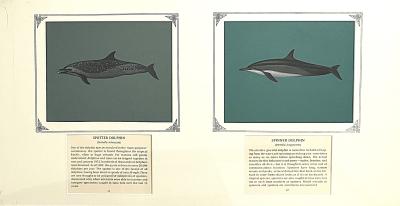PAINTINGS OF (a)BELUGA & (b)NARWHAL
c. 19752 paintings in single framed work (a) Beluga- white colored whale with bulbous "melon-shaped" head and no dorsal fin (54) (b) Narwhal - Stocky bodied, grey and white mottled colored whale, with blunt snout and distinctive spiraled tusk protruding from the head (55); gouache on blue card, framed and mounted with inscription .
Collection of 106 of paintings by Richard Ellis that were selected by the Smithsonian Institution to form a traveling exhibit of the marine mammals of the world. The collection was purchased by Perth businessman Kevin Parry in 1985 and donated to Whale World, now known as Albany's Historic Whaling Station.
Details
Details
BELUGA (Delphinapterus leucas)
The beluga is a robust, 18-foot white whale with a rounded, prominent forehead (the melon), and a low ridge on the back in place of a dorsal fin. It is found only in the Arctic, where it is often seen in large groups sometimes numbering tin the hundreds. Called the "sea canary: by the early whalers, the beluga (Russian for "white") is one of the noisiest of all whales, with a repertoire of whistles, squeals, chirps, barks, squawks, whinnies, and claps. Belugas do well in captivity, and are often seen as the stars of underwater oceanarium shows. To date, they have never been successfully bred in captivity. 54.
NARWAHL (Monodon monoceros)
Like the beluga, the narwhal is found only in the Arctic. Unlike the beluga though-and unlike any other animal on earth-the male narwhal has a greatly elongated "tusk"(actually a tooth) protruding from its upper jaw. This tooth, which may reach a length of 8 feet, is believed to be responsible for the myth of the unicorn. When these ivory spirals were brought to western Europe by the early Arctic travelers, it was probably necessary to invent an animal to go along with them, since it seemed so unlikely that the original owner was a little spotted whale. The actual use of the tooth is not known. Eskimos still hunt the narwhal for blubber and for the tusks, and the total narwhal population is believed to be decreasing. 55.
Verso: Smithsonian label checklist # 54 & 55 Packing case # 2, AWHS accession number
The paintings represent a body of work by well-known American marine conservationist, author, artist and natural historian Richard Ellis (1938-2024).
Copyright and Reference
Copyright and Reference
Albany's Historic Whaling Station
Albany's Historic Whaling Station
Other items by Richard Ellis
- PAINTINGS - SPOTTER DOLPHIN (11) & SPINNER DOLPHIN (12)
- PAINTINGS - (a) CARIBBEAN MONK SEAL (b) HAWAIIAN MONK SEAL
- PAINTING - HOURGLASS DOLPHIN
- PAINTINGS - (a) BAIRD'S BEAKED WHALE (b) GOOSEBEAK WHALE
- PAINTINGS - (a) FIN WHALE & (b)BLUE WHALE
- PAINTING - HEAVISIDE'S DOLPHIN
- PAINTING - STELLER`S SEA LION
- PAINTING - BAIKAL SEAL
- PAINTING - ATLANTIC WHITE SIDED DOLPHIN
- PAINTING -BEARDED SEAL
- PAINTING - SEI WHALE
- PAINTING -HECTOR'S DOLPHIN
Other items from Albany's Historic Whaling Station
- PAINTING - COMMERSON'S DOLPHIN
- PAINTING - DUGONG
- PAINTING - POLAR BEAR
- PAINTING - SEA OTTER
- PAINTING - RISSO'S DOLPHIN
- PAINTING - FINLESS PORPOISE
- PAINTING - STRAP-TOOTHED WHALE
- PAINTING - FALSE KILLER WHALE
- PAINTING -BLACK DOLPHIN
- PAINTING - SOUTHERN BOTTLENOSE WHALE
- PAINTING - COMMON DOPLHIN
- PAINTING - BOTTLENOSE DOLPHIN

